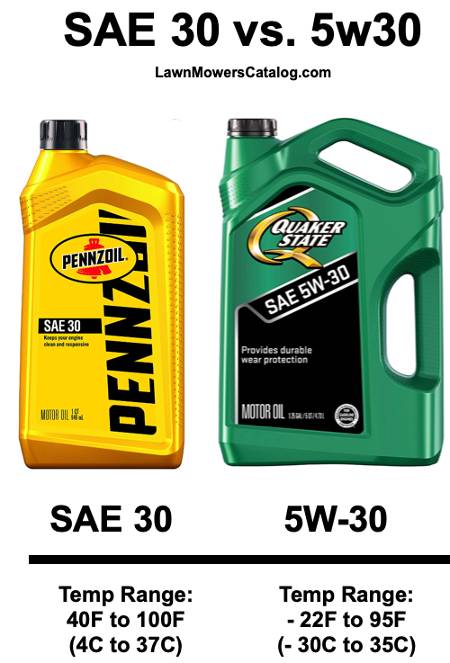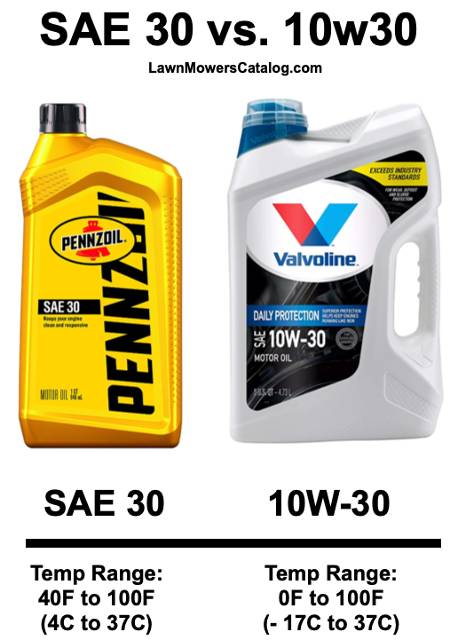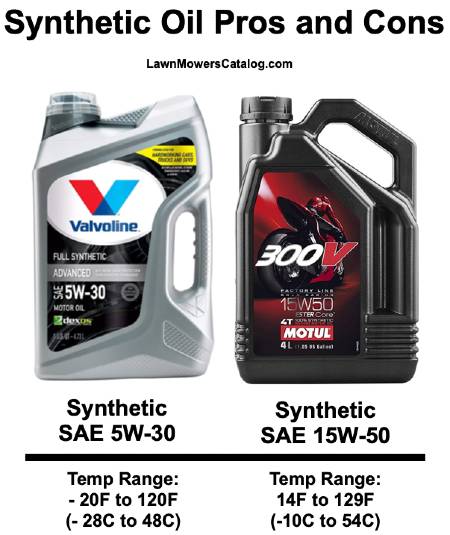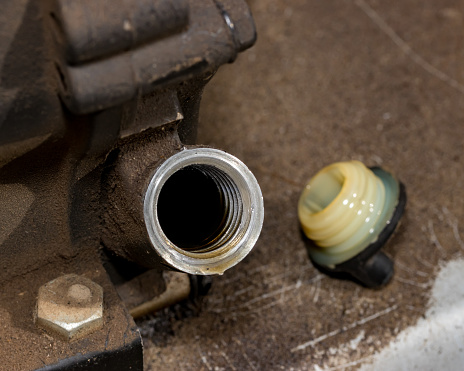Today you’re going to learn what kind of oil your lawn mower small engine requires.
And we’ll directly compare these types of oil:
- SAE 30 vs. 10w30
- SAE 30 vs. 5w30
- Synthetic oil vs. conventional oil
Here’s the gist of lawn mower oil types:
- The best type of oil for your lawn mower will depend on your climate since different oil is best for different temperature ranges.
- The common oil type is conventional SAE-30 because it has a common range of temperatures it should be used in:
- 40 Fahrenheit (4 Celsius) to 100 Fahrenheit (37 Celsius) which covers most of the climates in the US.
- If you live in a colder area conventional SAE 10W-30 may be better for you. It has a lower range and will improve starting in cold weather.
- 0 F (- 17 C) to 100 F (37 C)
- If you live in very cold climate then conventional SAE 5W-30 is your option as it is recommended for use under 40 F (4 C). Great for your snow blower.
- The most versatile one-and-done oil that works in all temps you see in the US is synthetic 5W-30 going from – 20 F (- 28 C) to 120 F (48 C). But given the specs it is more expensive.
- Another synthetic is SAE 15W – 50 pushing the limits of the operating temperature range to 130 F (54 C). Mainly for commercial riding mowers.
- Conventional vs synthetic is simple: Conventional works fine but synthetic works better but is more expensive. Your choice.
Here’s a video to watch on the subject:
Let’s compare directly.
SAE 30 vs. 5w30 – Which is Best?
SAE30 is cheaper and works great for most climates – it is the most common oil for lawn mowers.
The 5w30 oil has more temperature range and will work better in colder climates.
Let’s dig deeper.

The type of oil your lawn mower small engine requires depends on the climate you live in.
Each oil type is ideal for a certain temperature range because the oil’s viscosity (resistance to flow) will change based on hot or cold.
The colder weather causes the oil to have more resistance to flow. So you want a thinner oil for colder climates.
Comparison: Water flows easy and honey resists flow. Honey has high viscosity. Water has low viscosity. The more you heat up the honey the easier it will flow – less viscous.
In a lawn mower engine you are usually storing it in the shed and then when you come to start it it will be cold. As you mow the engine heats up and the oil flows better.
What do the numbers SAE 30 and 5W30 mean?
SAE = Society of Automotive Engineers
30 = Viscosity rating
5w30
- 5 = Viscosity at low temps so the engine will start in cold weather
- w = Winter
- 30 = Viscosity at high temps so the oil still lubricates and doesn’t thin out
SAE30 is a conventional single-grade oil with a viscosity rating of 30 by the Society of Automotive Engineers.
Engine oil viscosity is usually from 0 to 50.
- 50 viscosity is thick oil and best for high temperature engines.
- 5 viscosity is thinner oil and best for colder operating engines like snow blowers.
- So 30 is in the middle and great for many of the USA climates.
5w30 is a multi-grade oil meaning its viscosity changes with temperature and it is thin at start up but maintains thickness at normal engine operating temps.
SAE30 vs. 5w30 – Which is best for you?
If you live in a cold climate where your temperature is often below 32F (0C) you will need the 5w30 oil because the SAE30 will be too thick below 32F (0C) for you engine start.
If you live in a moderate climate like California coast then you can use the SAE30 because it is more affordable and will do the job of lubrication just fine.
SAE 30 vs. 10w30 – What’s The Difference?
SAE30 vs. 10w30 oil is a comparison many make.
But what’s the actual difference?
10w30 will be a better oil than SAE30 if you live in a cold climate and want to use a lawn mower in cold temps. It is often used in snow blowers.
If you look at the chart below you can see the SAE30 recommended use temps are: 40F (4C) to 100F (37C). Whereas the 10W-30 has more range: 0F (- 17C) to 100F (37C).

SAE30 is the most common engine oil for small engines and 10w30 is a great oil for colder climates like New Hampshire in winter.
Choosing SAE30 or 10w30 will depend on your climate. If you want an oil to perform better at lower temperatures then go with multi-grade 10w-30.
What about 5w30 vs. 10w30?
5w30 is better than 10w30 at very cold temps. Anything below 0F is going to favor 5w30 because 10w30 will become too thick to work at lubricating the engine components.
Synthetic Oil vs. Conventional Oil – Pros and Cons
Synthetic oil is engineered to perform better than conventional mineral oil in small engines.
As such, synthetic oil is more expensive.
Check out the chart below of synthetic oil 5w30 and 15w30 temperature ranges.

Let’s look at some pros and cons of conventional oil vs. synthetic oil:
Conventional Oil Pros and Cons
Conventional oil is the oil used for many riding and push mowers. It is made from minimally refined base oils.
- Pros: Affordable. Widely available.
- Cons: Only operates inside certain temperatures and the temperature range is smaller than synthetics and multi-grade oils. It is not as stable since it is less refined. It breaks down quicker which means you need to change the oil more often.
Synthetic Oil
Synthetic oil is made fhighly refined base oils to provide superior engine wear protection. It undergoes an extensive refining process that gives it better performance properties. Synthetic oil also has additives added to it, but these are different from the ones found in conventional oil.
- Pros: Has better performance. Lasts longer under tougher conditions. Less oil changes required. Keeps engine cleaner. Has a wide operating temperature range.
- Cons: Costs more money.
All in all synthetic oil is a superior product to conventional oil but costs more.
5 Tips For Changing The Oil In Your Lawn Mower
As any savvy homeowner knows, routine maintenance is essential for keeping your lawn mower in top condition.
One of the most important things you can do is regularly change the oil. This simple task helps to lubricate the engine and prevent excessive wear and tear.
Here are 5 tips to help you change the mower engine oil right:
- First, consult your owner’s manual to find out what type of oil is best for your lawn mower. You’ll also want to check how much oil your mower holds so that you can purchase the correct amount.
- Next, warm up the engine by running the mower for a few minutes. This will help to loosen any built-up grime and make it easier to drain the oil.
- Once the engine is warmed up, turn off the mower and remove the oil fill cap. Then, locate the oil drain plug and use a wrench to unscrew it. Be prepared for a small amount of hot oil to come out when you remove the plug.
- Allow all of the old oil to drain out completely before screwing the drain plug back in place. Then, use a funnel to change lawn mower oil into the fill hole. Then check the oil level.
- Finally, replace the oil fill cap and start up the engine to check for leaks.

All lawn mowers will included an oil fill cap and drain plug.
How Often Should You Change The Oil In Your Lawn Mower?
Any keen gardener knows that a well-maintained lawn is the cornerstone of a beautiful garden. A healthy lawn requires regular care and attention, and one of the most important aspects of lawn care is ensuring that the oil in your lawn mower is changed regularly. But how often should people change the oil in their lawn mower engines?
Most manufacturers recommend that you change the oil in your lawn mower every 50 hours of use. However, if you use your lawn mower frequently or for extended periods of time, you may need to change the oil more often. If you notice that your lawn mower’s engine is running hotter than usual, it’s also a good idea to change the oil.
While changing the oil in your lawn mower small engines may seem like a daunting task, it’s actually fairly straightforward. Simply drain the old oil from the engine, replace the filter, and then fill the engine with fresh oil. Always be sure to use the type of oil recommended by the manufacturer, as using the wrong type of oil can damage your lawn mower’s engine. With just a little bit of effort, you can ensure that your lawn mower runs smoothly and efficiently for years to come.
Some Common Problems With Lawn Mowers & How Can You Prevent Them From Happening:
Lawn mowers are a vital part of keeping your lawn looking its best. However, they can also be a source of frustration if they break down or don’t work properly. Some common problems with lawn mowers include:
- The engine not starting
- The blades not spinning
- The mower leaving behind patches of unruly grass
Luckily, there are some things you can do to prevent these problems from occurring. One of the most important things is to make sure you read the owner’s manual carefully before using the mower. This will help you understand how to properly operate the machine and avoid any damaging mistakes. It’s also important to keep the mower well-maintained by regularly cleaning it and changing the right oil when necessary. By taking these simple steps, you can help keep your lawn mower in good working condition for years to come.

Regular maintenance of your lawn mower is critical for a long, healthy life. Checking the oil levels before each use is simple and quick.
Wrapping Up
Different lawn mower oil types are available in the market, but you need to choose the one which is best suited for your lawn mower. The most common types of oil used in lawn mowers are conventional, synthetic, and biodiesel. But you should always consult your owner’s manual to find out what type of oil is best for your particular model. In general, it’s a good idea to change the oil in your lawn mower every 50 hours of use, or more frequently if you notice that the engine is running hotter than usual.
With just a little bit of effort, you can keep your lawn mower running smoothly and efficiently for years to come.
Further Reading
- Some lawn mowers have their oil drain plugs underneath the deck so you have to remove the lawn mower blade before draining the old oil. We hate this and prefer to recommend the best lawn mowers which have a drain plug that is easier to access.
- We did some math to find out how long it takes to mow a 1 acre lawn. Check it out. Also check out how many acres different sports fields are here.
- Want the best looking lawn on your street? Learn here how to mow stripes in your lawn so it looks like a ballpark.
- Check out our used lawn mower buying guide.

